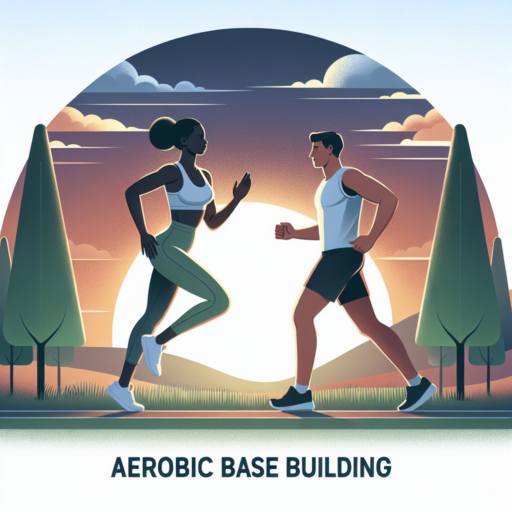No se han encontrado productos.
How to build an aerobic base for a beginner?
Building an aerobic base as a beginner is a fundamental step towards improving cardiovascular fitness and endurance. This initial phase of training is crucial for developing a strong foundation that will support more intense activities in the future. It involves low-intensity exercises that focus on increasing the heart rate to a point where the body starts to improve its ability to supply oxygen to muscles.
Start with Low-Intensity Cardio
Beginning your journey with low-intensity cardiovascular activities is key. Exercises such as walking, cycling, or swimming for 30 to 60 minutes can effectively build your aerobic capacity without putting undue stress on your body. Consistency is more important than intensity at this stage; aim for most days of the week, gradually increasing the duration as your fitness improves.
Incorporate Interval Training
Once a basic fitness level has been established, incorporating interval training can accelerate the development of your aerobic base. This technique involves alternating periods of more intense activity with periods of lighter activity. For instance, after a warm-up, you might cycle at a higher intensity for 1 minute followed by 2 minutes of leisurely cycling, repeating the cycle for 20 to 30 minutes.
Listen to Your Body
While following a structured training plan is important, listening to your body’s signals is equally crucial. Beginner athletes should pay attention to signs of excessive fatigue, such as prolonged muscle soreness or difficulty in performing regular activities, as these can indicate overtraining. Rest days are essential in allowing your body to recover and adapt to the increased demands of aerobic training.
By starting with low-intensity cardio, gradually incorporating interval training, and listening to your body, beginners can effectively build a solid aerobic base. This foundational phase not only enhances overall fitness but also prepares the body for more strenuous physical challenges ahead.
What should your heart rate be for aerobic base building?
Building a solid aerobic base is essential for improving fitness levels, enhancing endurance, and setting the foundation for higher intensity workouts. One of the most effective ways to ensure you’re in the right zone for aerobic base building is by monitoring your heart rate. This approach helps in optimizing the benefits of your training sessions without overexerting yourself.
To determine the ideal heart rate for aerobic base building, many athletes and fitness coaches rely on the Heart Rate Reserve (HRR) method or the Karvonen Formula. This involves calculating the difference between your maximum heart rate (MHR) and your resting heart rate (RHR), and then applying a percentage to find the right zone. Typically, for aerobic base building, staying within 60%-70% of your HRR is recommended.
Another popular method is based on the Maximum Heart Rate (MHR) calculation. To find your MHR, subtract your age from 220. Aerobic base training is then targeted at 50%-70% of your MHR. Many find this approach simpler, though perhaps less personalized than using the HRR method. Whichever method you choose, maintaining your heart rate within these specified ranges encourages your body to utilize fat as the primary source of fuel, efficiently building your aerobic capacity.
How can I build aerobic base without running?
Building an aerobic base is fundamental for enhancing cardiovascular health, endurance, and overall fitness. But what if running, a common go-to aerobic activity, isn’t an option for you due to personal preference, injury, or other reasons? Fortunately, there are effective alternatives to running that can help you develop a strong aerobic foundation.
Embrace the Power of Cycling
Cycling, either stationary or on-road, stands out as a superb alternative to running for building aerobic capacity. It’s low-impact, making it easier on the joints, and you can adjust the intensity to suit your fitness level. Sessions of moderate cycling can significantly boost your aerobic endurance without the high impact of running. Incorporating sessions that vary in intensity, from steady-state rides to high-intensity interval cycling, can optimize cardiovascular benefits.
Discover Swimming for Whole-Body Conditioning
Swimming is another exceptional way to build your aerobic base without running. It engages multiple muscle groups simultaneously, providing a comprehensive aerobic workout that improves not only your heart health but also muscular endurance. The buoyancy of water reduces strain on the body, making swimming an ideal choice for those seeking a low-impact exercise option. Regular swimming sessions, particularly those that include varying strokes and speeds, can greatly enhance aerobic capacity and stamina.
By exploring these alternatives to running, you can develop a robust aerobic base that supports your overall fitness and health goals. Whether you choose cycling, swimming, or a combination of both, the key is consistency and gradually increasing the intensity and duration of your workouts. Remember, building an aerobic base takes time and dedication, but the benefits to your health and well-being are well worth the effort.
How to build aerobic base cycling?
Building a strong aerobic base through cycling is a cornerstone for any cyclist looking to improve stamina, speed, and overall performance. This process involves gradually increasing the volume and intensity of your rides to enhance your cardiovascular system’s efficiency. Getting this foundation right can significantly impact your cycling experience, whether you’re a seasoned pro or a beginner.
Starting with Low-Intensity Rides
To begin building your aerobic base, focus on low-intensity rides that allow you to maintain a conversation comfortably. This level of effort encourages your body to use fat as its primary fuel source, enhancing your endurance and teaching your body to conserve glycogen. Consistency is key; aim for long rides at a steady pace to effectively build your aerobic capacity without overstraining yourself.
Incorporating Interval Training
Once you have established a solid base of low-intensity training, integrating interval training can take your aerobic capacity to the next level. Sessions that alternate between high-intensity bursts and recovery periods boost your cardiovascular system, improving both aerobic and anaerobic fitness. Ensure to maintain a balance; too much high-intensity training can be counterproductive, leading to burnout and overtraining.
Remember, building an aerobic base in cycling is a gradual process that requires patience and dedication. By starting with foundational low-intensity rides and progressively incorporating varied training methods, you can achieve substantial improvements in your aerobic fitness. This, in turn, lays the groundwork for more challenging endeavors and overall success in cycling.




